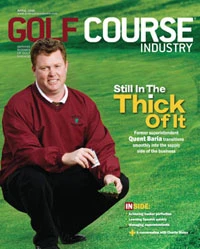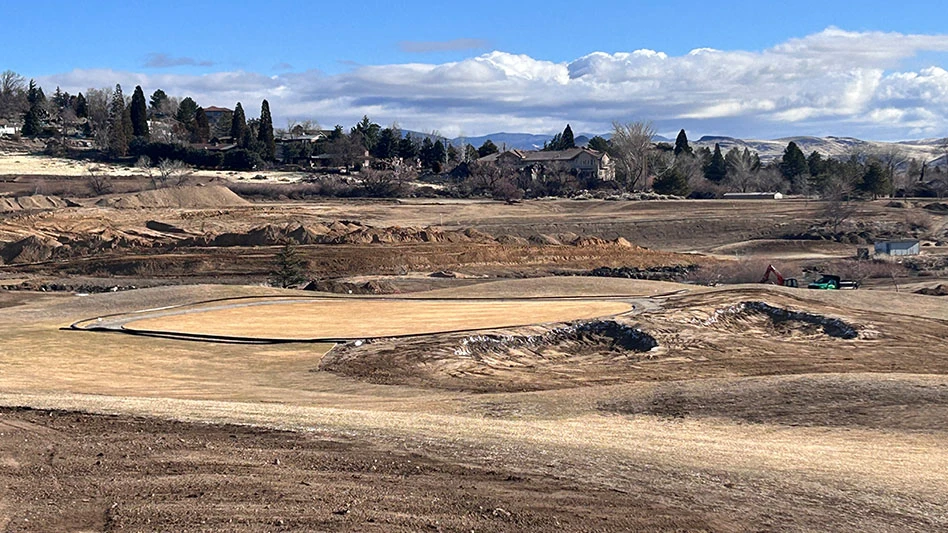On the surface, a subpar golf course will look pretty sometimes. But under stress, poor soil and drainage, and other fundamental flaws will always be evident. Similarly, golf course superintendents who polish the skills they need to improve can end up having a few more areas of expertise. By doing so, they become more marketable and valuable in the eyes of owners.
The GCSAA’s Professional Development Resource helps superintendents learn to improve those skills. The primary goal of the PDR tool is to help superintendents accurately assess their skills, determine what improvements they need and pinpoint educational opportunities to address them. The site makes it simple. Through a series of yes/no questions answered in a self-assessment, the program highlights knowledge gaps and recommends association training opportunities to help close those gaps. The analysis compares superintendents’ skills with the base skills for a Class A and certified member.
Hannes Combest, director of educational programs at the GCSAA, leads the strategic push to improve members’ skills. She says it took five years to develop the PDR, which was introduced in 2001 to assist superintendents by outlining key areas of expertise, known as competencies on the education front. The core competencies developed from the original skills GCSAA members believed strong superintendents should have. Those skills were defined in the PDR.
Aided by the skills gap analysis, Shawn Sheridan earned his certification within the past year. A GCSAA member for 19 years, Sheridan originally earned a degree in turfgrass management from The Ohio State University. He likes how the analysis helped focus his career.
“The process made me think hard about my skills and career,” says the superintendent of Diamondback Golf Club in Haines City, Fla. “I felt I needed to answer honestly to get an accurate assessment of my abilities and to highlight areas that needed improvement.”
The idea behind the skills-gap analysis is to shrink a superintendent’s knowledge gap.
“It pointed out areas where I needed more depth,” says Sheridan, who was impressed with the accuracy of the feedback in terms of the knowledge depth in each category.
Bruce Constable, CGCS, at Woodside Golf Club in Airdrie, Alberta, Canada, likes the development action plan the PDR tool creates.
“The biggest benefit of using the Professional Development Resource is that you get to develop a plan that will help you to improve your skills in certain areas,” Constable says.
The development action plan helps superintendents chart a course of learning through their weaker areas to progress toward certification. Sheridan believes the approach helps boost one’s career.
“We need to take the time to evaluate ourselves, seek out our weaknesses, address them and become more valuable to our current or future employers, which I feel is the biggest benefit of the system,” he says.
Strong, successful facilities are usually led by superintendents who are capable of identifying flaws – even in their own knowledge base.
“If you answer the self assessment questions honestly, you’ll get an accurate gap analysis that will help lead you down a good study path,” says John Magnuson, CGCS, at Murphy Creek Golf Course in Aurora, Colo. “The development action plan allows you to set your own practical plan for completing the learning phase of competencies that showed weak in the gap analysis.”
Whether it’s information about ornamentals or EPA regulations, a pertinent course will be recommended to address the need.
“Financial management was one area in which I needed to make improvements, and the online course ‘Developing Financial Savvy in the Golf Business’ was valuable to me in that regard,” Constable says. “It was narrated by Cleve Cleveland, CGCS, who made the material quite interesting.”
Sheridan says his experience with the tool illuminated a need to learn more about governmental issues and record-keeping.
Benefiting owners
Fewer weaknesses mean better decision-making, better courses and happier owners – all good things for a superintendent’s career. Henry DeLozier agrees wholeheartedly. As the vice president of golf for Pulte Homes, DeLozier believes the company’s 20 golf properties benefit from the learning the GCSAA fosters among superintendents.
“I’m really a big fan of what the GCSAA is doing to help grow the intellectual capability of the golf course superintendent,” he says. “The GCSAA seems to have its finger on the pulse of what golf course owners and operators need.”
DeLozier refers to a symposium at this year’s Golf Industry Show in Anaheim, Calif., as proof. The superintendents who used the PDR were better informed and knew what material owners were interested in, he says.
It’s important for superintendents to remain current with the site’s new information, says DeLozier, who believes the site provides an invitation for owners and superintendents to discuss key issues.
“It’s a useful tool for owners and superintendents to find themselves working toward a common understanding,” he says. “A lot of owners, especially those that are involved in the decision-making processes at their golf properties, find value in discussing topics covered on the site.”
As a person responsible for leveraging golf properties to bring higher value to homeowners in a golf community – there are 30 new ones being planned – DeLozier understands the need for better communication with superintendents about many topics.
“Any time that we go on site together, it’s stimulation for discussion,” he says. “It fosters good, open discussion about strategic issues.”
DeLozier recalls a situation in which a discussion about equipment replacement plans was sparked by something on the Web site.
“Everyone thought they were in agreement when it came to mower obsolescence, but after some talk about specifics and how each person defined the term ‘obsolete,’ everyone had better knowledge of the others’ perspectives,” he says.
A discussion like that can help owners and superintendents understand each other better, DeLozier says. The Web site can help owners and even long-time superintendents come together in their approach on numerous topics.
While the tools on the Web site aren’t marketed to owners, they still increase value for owners when superintendents use them, Combest says.
“It’s a tool designed to help people map out programs to address their weaknesses and perform more successfully,” she says.
Because superintendents appreciate their contribution to the success of a course as a business, helping owners understand what the superintendent adds to the business equation should be part of every member’s mind-set, Combest says.
“It’s been an education process on our part to try to help people understand that relating the skills and knowledge they have to the success of the facility is important,” she says.
More usage
Because the PDR tool has the long-standing competencies at its foundation, it continues to strengthen the profession, Combest says.
“It’s not just the PDR, it’s having the competencies, and what that has done for this profession is make it a profession,” she says. “It has defined it.”
Still, Combest hopes more members will use the tool.
“The PDR isn’t used extensively, and that’s one of the things we’re trying to change,” Combest says. “One of the most likely reasons it isn’t used more, some superintendents say, is the time required to complete it and the recommended training.”
One longtime professional, Terry Rodenberg, superintendent at St. Andrew’s Golf Club in Overland Park, Kan., says he just wouldn’t have enough time in the day to complete his work and go through the PDR and all the training needed to become certified. He acknowledges there’s little reason at the upscale municipal course he works at to spend a lot of his own time on training for certification.
“I’m in my 25th year with my employer,” Rodenberg says. “There’s not an incentive to be certified.”
Rodenberg says the city provides a lot of training opportunities for him and that keeps him current with the field.
Still, Combest encourages members to review the PDR analysis first, before beginning courses for the certification exam. She also notes that key information presented in training is marked as crucial for the certification exam.
“What we’ve realized is that we need to highlight that this is something you need to know for certification,” she says.
Sheridan believes all facets of responsibility are represented in the analysis and must be cultivated to succeed in one’s career.
“I don’t know everything, but this process has indicated areas that, to be the best I can be as a CGCS, need to be addressed and how to address them,” he says.
Even after a superintendent reaches the pinnacle of becoming certified, learning doesn’t stop. With all the changes in regulations and technology, it’s too easy for superintendents to fall behind if they don’t focus on keeping pace with them.
“I can continue to use my development action plan to plot the course for my future educational activities,” Constable says. “I’m a lifelong learner and will continue to build my skill set using the resources the GCSAA has to offer.” GCI
Get curated news on YOUR industry.
Enter your email to receive our newsletters.

Explore the April 2008 Issue
Check out more from this issue and find your next story to read.
Latest from Golf Course Industry
- The Cabot Collection announces move into course management
- Carolinas GCSA raises nearly $300,000 for research
- Advanced Turf Solutions’ Scott Lund expands role
- South Carolina’s Tidewater Golf Club completes renovation project
- SePRO to host webinar on plant growth regulators
- Turfco introduces riding applicator
- From the publisher’s pen: The golf guilt trip
- Bob Farren lands Carolinas GCSA highest honor





